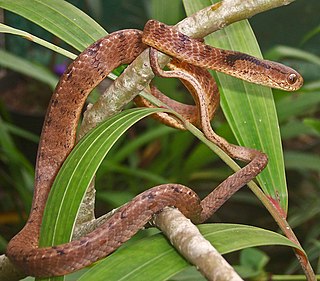
Hemiphyllodactylus is a genus of geckos ranging from India and China southward to Southeast Asia and Oceania. Species of Hemiphyllodactylus are commonly known as half leaf-fingered geckos. Many species are known as dwarf geckos or slender geckos.

Salamandridae is a family of salamanders consisting of true salamanders and newts. Salamandrids are distinguished from other salamanders by the lack of rib or costal grooves along the sides of their bodies and by their rough skin. Their skin is very granular because of the number of poison glands. They also lack nasolabial grooves. Most species of Salamandridae have moveable eyelids but lack lacrimal glands.

The Rhacophoridae are a family of frogs in tropical sub-Saharan Africa, South India and Sri Lanka, Japan, northeastern India to eastern China and Taiwan, south through the Philippines and Greater Sundas, and Sulawesi. They are commonly known as shrub frogs, or more ambiguously as "moss frogs" or "bush frogs". Some Rhacophoridae are called "tree frogs". Among the most spectacular members of this family are numerous "flying frogs".

Amolops is a genus of true frogs native mainly to eastern and south-eastern Asia. These frogs are closely related to such genera as Huia, Meristogenys, Odorrana, Pelophylax and Rana, but still form a distinct lineage among the core radiation of true frogs. They are commonly known as "torrent frogs" after their favorite habitat - small rapid-flowing mountain and hill streams - but this name is used for many similar-looking frogs regardless of whether they are loosely related.

Lycodon is a genus of colubrid snakes, commonly known as wolf snakes. The Neo-Latin name Lycodon is derived from the Greek words λύκος (lykos) meaning wolf and οδόν (odon) meaning tooth, and refers to the fang-like anterior maxillary and mandibular teeth. They are nonvenomous, but many members of this genus strongly resemble the venomous kraits in appearance, an example of Emsleyan mimicry.

Paramesotriton, also known as warty newts or Asian warty newts, is a genus of salamanders in the family Salamandridae. The genus is found in southwestern and southern China and in northern Vietnam. Most of the species are endemic to China, and the majority of them have been described recently, since 2008. The genus includes both pond and stream dwellers.

Opisthotropis is a genus of snakes in the subfamily Natricinae of the family Colubridae. The genus is native to Southeast Asia and South China.

Pareas is a genus of Asian snakes in the family Pareidae. All species in the genus Pareas are harmless to humans.

Sinomicrurus is a genus of venomous elapid snakes, one of several genera commonly known as Asian coral snakes or oriental coral snakes. The genus includes nine subtropical species found in Asia. Molecular and morphological analysis suggest this new genus is part of the family Elapidae.

Saurosphargidae is an extinct family of marine reptiles known from the Early Triassic and early Middle Triassic of Europe and China.

Hebius is a genus of snakes in the family Colubridae.
Zhao Ermi was a Chinese herpetologist, born in Chengdu. His ancestors were Manchu Bannerman of Irgen Gioro clan who were stationed in Chengdu during Qing dynasty. He studied biology at West China Union University, under the tutelage of Liu Chengzhao. He was elected a member of the Chinese Academy of Sciences in 2001. He died at West China Medical Center of Sichuan University on 24 December 2016.
Herpetoreas is a genus of snakes in the subfamily Natricinae of the family Colubridae. The genus is endemic to South Asia.
Diploderma zhaoermii is a species of lizard in the family Agamidae. The species is endemic to Sichuan, China.

Cristidorsa is a genus of lizards in the family Agamidae native to India and Myanmar. The name Cristidorsa is Latin for "ridged dorsum", in reference to the ridges on the backs of lizards in this genus. The common name ridged dragons was suggested by the authors of the 2018 genus description. The species were originally placed in the genus Japalura.

Diploderma is a genus of lizards in the family Agamidae. Species of Diploderma are native to Myanmar, China, Vietnam, Taiwan, and Japan. Most of the species are found in China, including many endemics.
Diploderma grahami, also known commonly as Graham's japalure, is species of lizard in the family Agamidae. The species is endemic to China.
Hebius septemlineatus, the Tengchong keelback snake, is a species of snake of the family Colubridae. It is endemic to western Yunnan, China. The vernacular name refers to its type locality, Tengchong.
Hebius weixiensis, the Weixi keelback snake, is a species of snake of the family Colubridae. It is endemic to China and known from around Lijiang in Yunnan. The specific name weixiensis refers to its type locality, Weixi County.

Boulenophrys is a genus of frogs in the family Megophryidae. They occur in the China, Mainland Southeast Asia and Northeast India. It had been placed variously as a subgenus or synonymy of Megophrys. Dubois, Ohler and Pyron first recognized that Panophrys is preoccupied and employed Boulenophrys as the generic name rather than Tianophrys under the Principle of First Revisor.













